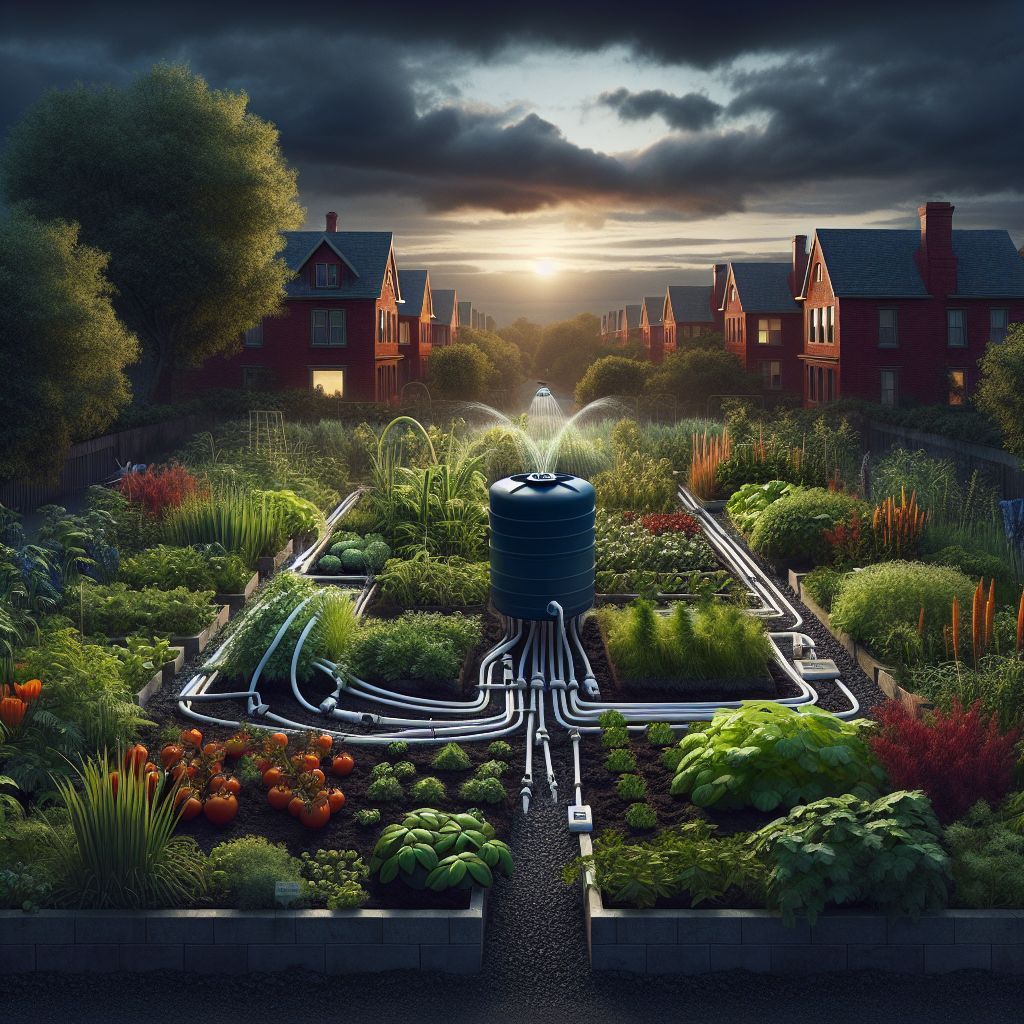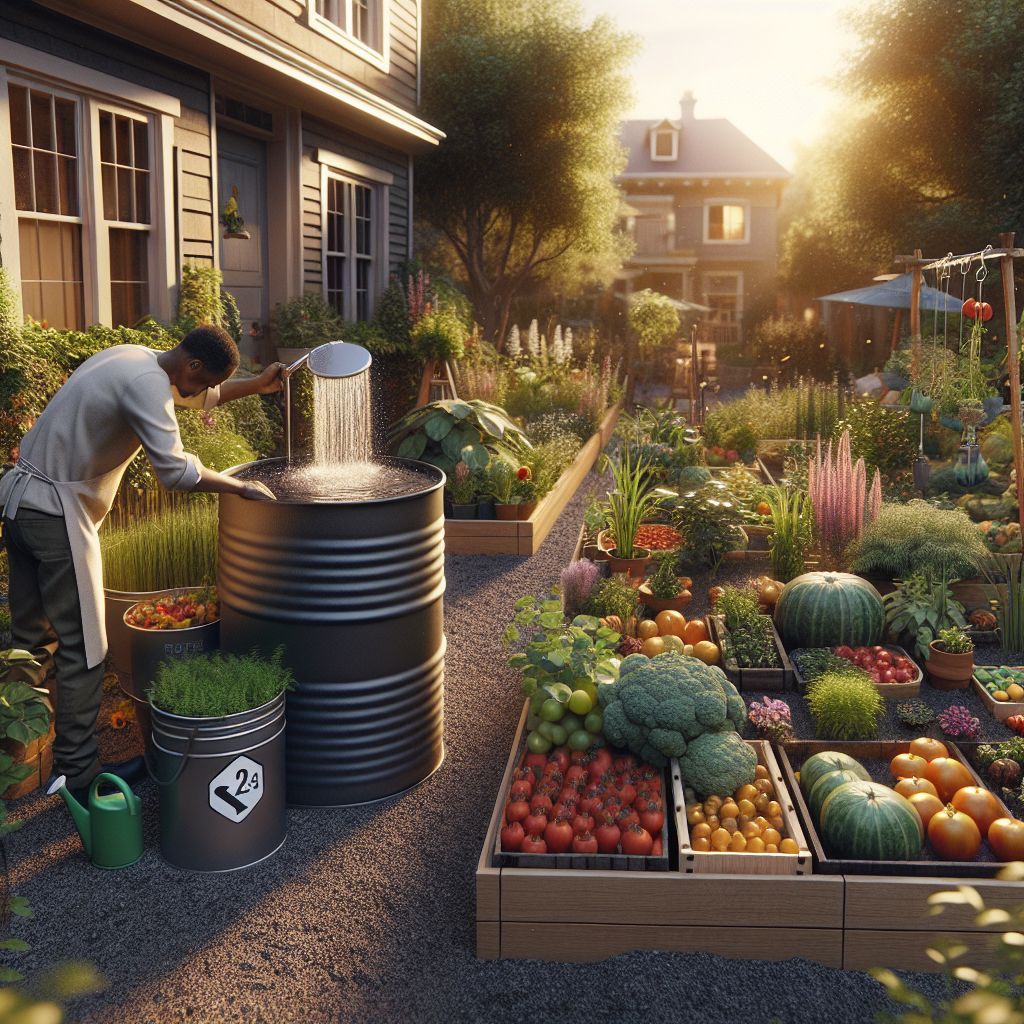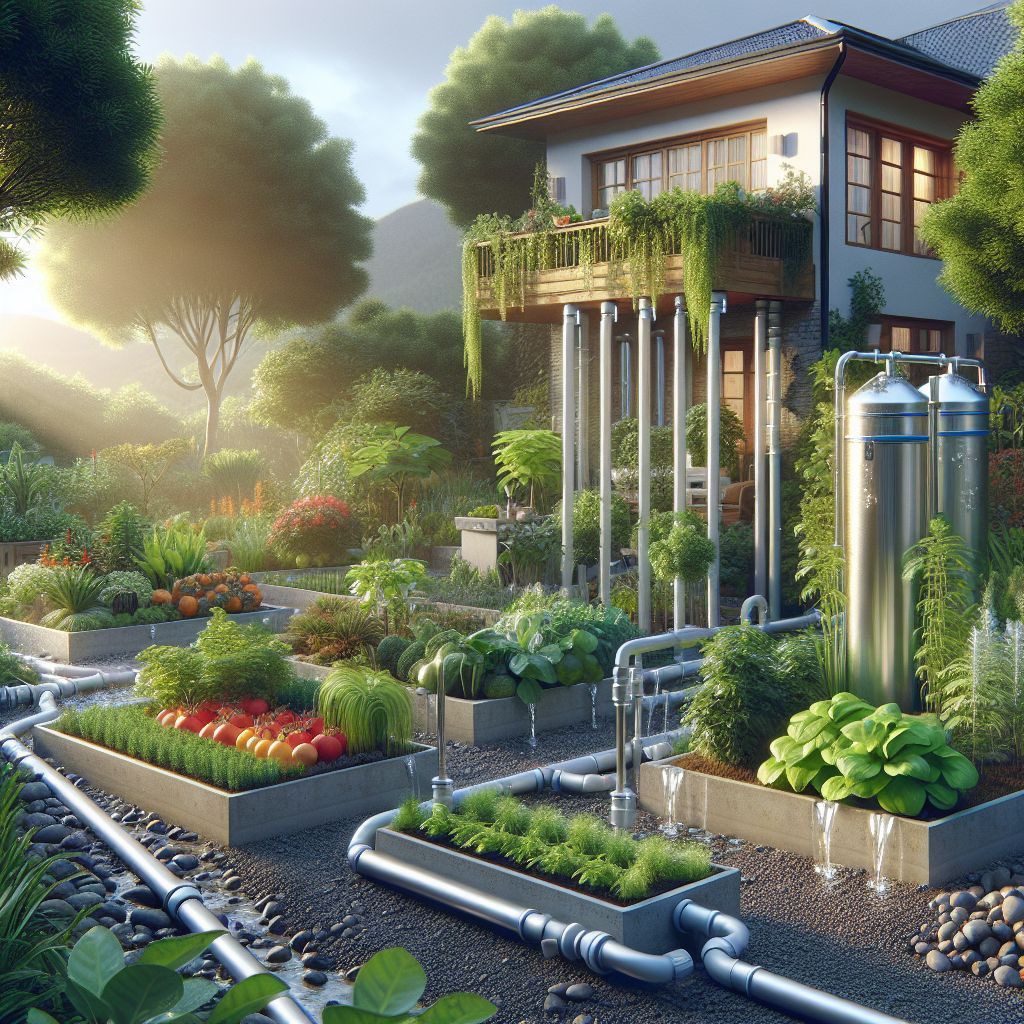
Key Takeaways: Gray Water in Your Garden
- Gray water is wastewater from household sources like showers and washing machines, excluding toilet waste.
- Using gray water can significantly reduce your freshwater usage, benefiting the environment and your wallet.
- Gray water can provide plants with essential nutrients, but it’s crucial to use the right kind of gray water and avoid harmful substances.
- Setting up a gray water system can be simple, and there are plants that thrive on gray water irrigation.
- It’s important to be aware of local regulations and health considerations when using gray water in your garden.
When you’re done with your shower, what happens to the water that spirals down the drain? Most people don’t give it a second thought. But what if I told you that water – which we call gray water – could be a secret weapon in your garden? That’s right, with a bit of know-how, you can turn what’s essentially waste into a resource that not only saves you money but also gives your plants a boost.
The Lifeline of Leftover Water: Gray Water 101
First things first, let’s get clear on what gray water is. It’s all the water that drains from your showers, bathroom sinks, and laundry machines. It’s not fresh, but it’s not sewage either. That’s black water, and it’s a different story. Gray water can be full of potential, packed with microbits of organic material that your plants might just love.
Defining Gray Water and Its Sources
Imagine every time you wash your hands or take a shower, you’re not just getting clean, you’re creating a mini river of resources that can flow right into your garden. The same goes for when you do laundry – except for those heavy-duty dirty loads or when you use harsh chemicals. Those are no-nos for the garden.
Comparing Gray and Black Water: Usage Guidelines
So, how do you tell the difference between gray and black water? It’s simple. Gray water is the gently used water from your showers, sinks, and washers. Black water comes from your toilet and, in most cases, from your kitchen sink and dishwasher too. It’s because of the food bits and grease – they can attract pests and cause odors. That’s why black water should never be used in your garden. To ensure the safety and effectiveness of using gray water in your garden, consider learning more about community survival garden setup and best practices.
Perks of Using Gray Water in Your Garden

Now, let’s talk about why using gray water is such a smart move. Besides the obvious – saving precious fresh water – there are some other big wins for your garden.
- Water Conservation: You’re basically getting two uses out of the same water. That’s efficiency at its best!
- Nutrient Recycling: Gray water can contain traces of organic material, like skin cells and food particles, which can be a bonus for your plants.
- Healthier Soil: Regular watering with gray water can keep your soil moist and healthy, which is great for your plants’ roots.
- Reduced Water Bills: Less fresh water used means more money in your pocket. It’s a win-win for you and the planet.
Rethinking Water: Sustainability and Your Plants
Think of gray water as part of a cycle. You use water in your home, it helps your plants grow, and they, in turn, give back to the environment. It’s a beautiful loop that reduces waste and makes the most of what we have.
Unlocking Nutrients: How Gray Water Helps Plants Thrive
Most importantly, plants aren’t picky. They don’t always need pristine water to flourish. In fact, the bits of organic matter in gray water can provide them with nutrients. But, because it’s not as clean as rainwater, you’ve got to be choosy about what gray water you use and how you use it.
Let’s break this down into smaller pieces: understanding the essential urban gardening tools can significantly enhance your gardening efficiency.
Firstly, gray water from your shower or bathroom sink is usually a safe bet. Just make sure you’re using eco-friendly soaps and shampoos. Your plants will thank you by absorbing the extra nutrients without the harsh chemicals.
Secondly, laundry water can be a plant’s best friend, but only if you’re using the right detergent. Skip the bleach and opt for a plant-friendly option. It’s like giving your garden a health drink packed with goodies.
And there you have it, the first steps towards understanding and utilizing gray water in your garden. Stay tuned for the next part, where we’ll dive into setting up your garden for gray water success and the plants that will thrive with this eco-friendly practice.
Unlocking Nutrients: How Gray Water Helps Plants Thrive
Most importantly, plants aren’t picky. They don’t always need pristine water to flourish. In fact, the bits of organic matter in gray water can provide them with nutrients. But, because it’s not as clean as rainwater, you’ve got to be choosy about what gray water you use and how you use it.
Setting Up Your Garden for Gray Water Success
Before you start pouring gray water onto your plants, there’s a bit of setup involved. You want to make sure you’re doing it right to keep your plants happy and healthy. That means thinking about how you’ll collect the gray water, how you’ll filter it, and where it’ll go in your garden.
DIY Gray Water Systems: Simple Steps for Home Gardeners
Setting up a DIY gray water system doesn’t have to be complicated. Start by connecting a hose to the drainpipe of your washing machine. This is often the easiest source of gray water to tap into. Make sure you’re using a biodegradable detergent to keep your plants safe.
Next, you’ll need a simple filtration system to remove lint and other particles from the water. This can be as easy as a bucket with holes and a layer of gravel or a commercial gray water filter. Now, you’re ready to water your plants directly or fill a watering can for more targeted irrigation.
Example: Sarah, an avid gardener, uses a three-tiered filtration system made from household items to clean her gray water. She starts with a coarse mesh to catch the big bits, then a layer of sand for the smaller particles, and finally, a layer of activated charcoal to remove any residual soap. Her plants have never been happier.
Remember, the goal is to keep it simple and efficient. You’re repurposing water, not setting up a science lab. With a basic system, you can start saving water and helping your garden grow.
Plants That Love Gray Water: Making the Right Choices
Now, not all plants are ideal for gray water. You’ll want to choose those that are less sensitive to the slight changes in pH and potential salt content that gray water can bring. Here are some great candidates for gray water:
- Fruit trees and bushes like apple trees and raspberry bushes
- Ornamental plants such as roses and lavender
- Hardy vegetables like tomatoes and squash
- Grasses and groundcovers that are used to variable conditions
These plants are not only robust but can also benefit from the additional nutrients that gray water provides. Plus, they’re less likely to be affected by any soaps or cleaners that might be in the water.
Potential Pitfalls and Smart Solutions

While gray water gardening is a smart move for many, there are potential pitfalls to be aware of. For example, the use of unsuitable soaps and detergents can harm plants. It’s also important to avoid overwatering or concentrating gray water in one area, as this can lead to soil and plant issues.
Navigating Health Concerns with Gray Water
Health concerns are paramount when using gray water. Always avoid using gray water from washing diapers or cleaning household items that have come into contact with raw meat. Additionally, it’s not recommended to use gray water on plants that are for direct consumption, like lettuce or carrots, unless you’re certain the water is free from harmful pathogens.
Therefore, the key is to use gray water wisely and responsibly. By understanding the source and content of your gray water, you can mitigate most health risks.
Maintaining the Balance: Preventing Soil Degradation
One of the challenges of using gray water is preventing soil degradation. Gray water often has higher levels of salt and possibly other elements that can build up over time and harm your soil and plants. To prevent this:
- Rotate where you apply gray water in your garden.
- Choose plants that are tolerant of higher salt levels.
- Use gray water in conjunction with rainwater harvesting or fresh water to dilute any potential buildup.
By following these steps, you can maintain a healthy balance in your garden soil, ensuring that your plants continue to thrive.
Transforming Your Garden Practice
Using gray water is a powerful way to transform your gardening practice into a more sustainable and eco-friendly one. It’s about seeing the potential in what we often consider waste and using it to nurture and grow. With the right approach, you can turn your garden into a model of sustainability.
Continuing Care: How to Sustain Your Garden with Gray Water
Gray water gardening isn’t a ‘set it and forget it’ kind of deal. It’s about building a relationship with your garden, understanding its needs, and responding accordingly. This means regular monitoring of soil moisture and quality, as well as being mindful of the plants’ responses to gray water irrigation.
- Monitor soil moisture levels to prevent overwatering.
- Test soil quality periodically to check for salt or chemical buildup.
- Observe plant health and adjust your gray water usage if you notice any signs of stress.
- Consider using a mulch layer to help retain moisture and protect your plants from direct contact with gray water.
Remember, the goal of using gray water is to support your garden’s growth while being eco-friendly. By staying attentive and adapting your practices, you can ensure that your garden remains a thriving, sustainable oasis.
And if you’re looking to take your sustainable gardening to the next level, consider exploring the range of heirloom seeds at Survival Essentials. Their curated selection can help you cultivate a garden that’s not only resilient but also rich in biodiversity.
Frequently Asked Questions (FAQ)
You’ve got questions, and I’ve got answers. Let’s tackle some of the most common queries about using gray water in your garden.
Remember, when in doubt, it’s always a good idea to consult with local experts or extension services to ensure you’re following the best practices for your specific region and garden setup.
Is Gray Water Safe for All Plants?
Mostly, yes. But some plants are more sensitive than others. Gray water is generally safe for ornamental plants and established trees and shrubs. For edible plants, it’s best to avoid using gray water on anything you’ll eat raw, like lettuce or berries, unless you’re certain the water is free from contaminants.
How Do I Filter Gray Water Before Using It in the Garden?
Filtering gray water can be as simple as using a bucket with holes lined with a mesh bag to catch lint and hair. For a more advanced setup, consider a bioreactor or a commercial gray water system with built-in filtration.
Can I Use Gray Water From My Dishwasher or Kitchen Sink?
Generally, it’s not recommended because this water can contain food particles, grease, and potentially harsh detergents. Stick to water from showers, baths, and laundry for the safest bet.
How Often Should I Use Gray Water for Irrigation?
It depends on your plants and climate. Start by replacing one or two regular watering sessions with gray water and observe how your plants react. Adjust as needed, keeping an eye on soil moisture and plant health.
And remember, during rainy seasons, you may not need to use gray water as often. Nature’s doing the job for you!
Are There Legal Restrictions on Using Gray Water?
Yes, there can be. Laws vary widely from place to place. Some areas encourage gray water use, while others have strict regulations or even outright bans. It’s crucial to check your local laws before setting up a gray water system.
For instance, some regions might require a permit or have specific guidelines on how gray water must be treated before use. Others might restrict the type of detergents you can use if you’re planning to repurpose laundry water.
Understanding these regulations will help you create a gray water system that’s not only effective but also legal.
Using gray water in your garden is a smart, sustainable practice that can lead to a lush, thriving landscape. It’s about making the most of every drop, reducing waste, and giving back to the earth. By following the guidelines and tips provided, you can ensure that your garden is not just surviving, but flourishing with the help of recycled gray water.






